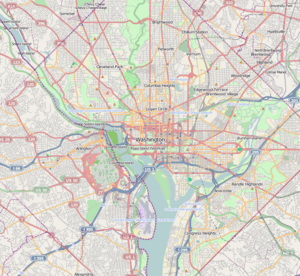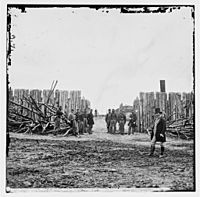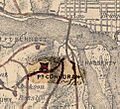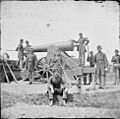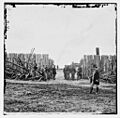Fort Corcoran facts for kids
Quick facts for kids Fort Corcoran |
|
|---|---|
| Part of the Civil War defenses of Washington, D.C. | |
| Arlington, Virginia | |

The Fighting 69th; Irish Brigade, New York Volunteer Regiment, United States attend church services at Fort Corcoran in 1861.
|
|
| Coordinates | 38°53′46″N 77°04′33″W / 38.896111°N 77.075833°W |
Fort Corcoran was a fort built by the Union Army in northern Virginia. It was part of the defenses that protected Washington, D.C. during the American Civil War. Built in 1861, soon after Union soldiers took over Arlington, Virginia, the fort guarded the southern end of the Aqueduct Bridge. It also looked over the Potomac River and Theodore Roosevelt Island, which was then called Mason's Island.
The fort was named after Michael Corcoran, a Colonel who led the U.S. Fighting 69th Infantry. This group, known as the Irish Brigade, was one of the units that helped build the fort. Fort Corcoran was home to the Union Army Balloon Corps and served as the main office for Washington's defenses south of the Potomac River. It was used throughout the war and was taken apart in 1866. Today, there are no parts of the fort left, but a historical marker shows where it once stood.
Contents
Early Days of the Civil War
Northern Virginia Before the War
Before the Civil War began, Alexandria County (now Arlington County) was mostly farmland. It was the closest county in Virginia to Washington, D.C. This land was once part of the District of Columbia but was given back to Virginia in 1847. Most of the county was hilly. In 1861, most people lived in the town of Alexandria. The rest of the county had scattered farms and plantations, like Abingdon Plantation. There were also fields for animals and Arlington House, owned by Mary Anna Custis Lee, wife of Robert E. Lee.
Virginia Decides to Leave the Union
After Fort Sumter was attacked in Charleston, South Carolina, on April 14, 1861, President Abraham Lincoln said that a rebellion was happening. He asked for 75,000 soldiers to stop it. This made many southern states upset. Virginia decided to vote on whether to leave the Union. On May 23, 1861, Virginia voted to leave the Union by a large margin.
That same night, U.S. Army troops started crossing the bridges from Washington, D.C., into Virginia. Brigadier General Joseph K. Mansfield, who was in charge of the troops in Washington, believed that Northern Virginia should be taken over quickly. This would stop the Confederate Army from putting cannons on the hills of Arlington and firing at government buildings in Washington. He also wanted forts built on the Virginia side of the Potomac River. These forts would protect the ends of the Chain Bridge, Long Bridge, and the Aqueduct Bridge.
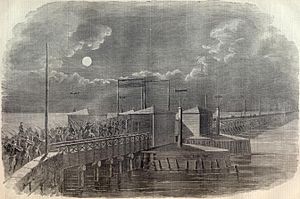
The occupation of Northern Virginia was mostly peaceful. However, there was one sad event in Alexandria. Colonel Elmer E. Ellsworth, who led the New York Fire Zouaves, was killed. He was shot by the hotel owner, James Jackson, while trying to remove a Confederate flag flying above the hotel. Ellsworth was one of the first soldiers killed in the American Civil War.
Building Fort Corcoran
Planning and Construction
On May 24, 1861, over 13,000 Union soldiers marched into Northern Virginia. They brought tools like wheelbarrows and shovels. Engineer officers, led by Colonel John G. Barnard, went with the army. They started building forts and trenches along the Potomac River to defend the bridges. By sunrise on May 24, work had already begun on the first two forts: Fort Runyon and Fort Corcoran.

Fort Corcoran was named after Colonel Michael Corcoran, who led the 69th New York Volunteer Regiment. This regiment, part of the famous Irish Brigade, worked hard on the fort. Their chaplain, Father Thomas Mooney, even baptized the fort's cannons! This was seen as disrespectful by his bishop, and he was called back to New York.
Building these first forts was difficult because there were not many soldiers available. For seven weeks, Barnard and his engineers focused almost all their efforts on Fort Corcoran and Fort Runyon. They had limited supplies. Just as Barnard was planning to connect these forts into a larger defense system, the Confederate Army approached. This led to the First Battle of Bull Run, and the engineers had to stop their work.
Making the Fort Stronger
After the Union Army lost the Battle of Bull Run, everyone was worried about a Confederate attack on Washington. People quickly worked to make the forts stronger. Many temporary trenches and blockhouses were later improved and became permanent defenses around Fort Corcoran. On July 23, President Abraham Lincoln and Secretary of State William H. Seward visited Fort Corcoran. They wanted to boost morale after the defeat at Bull Run.
On July 26, 1861, Maj. Gen. George B. McClellan took command of the military district of Washington. He was shocked by how weak the city's defenses were. Fort Corcoran itself was very crowded with many artillery units. A report from July 29, 1861, said Fort Corcoran had more than its planned 12 guns and 180 artillerymen. It had "12 8-inch seacoast howitzers, seven 24-pounder barbette guns, two 12-pounder field guns, and two 24-pounder howitzers." More than 200 dedicated artillerymen and many other soldiers were manning these guns.
To fix this, McClellan ordered that the forts defending Washington be made much larger and stronger. For Fort Corcoran, a section of trees was cut down in front of Arlington. New gun batteries were built along the ridge in front of Fort Corcoran. Some of this work was done by troops led by William Tecumseh Sherman, who later became a famous general.
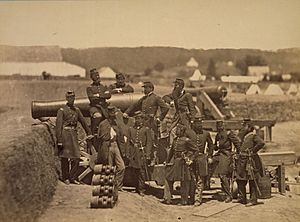
In October 1862, Edwin M. Stanton, the Secretary of War, ordered a group of civilians to study Washington's defenses. They suggested building a new fort behind Tillinghast and Cass. This would make Fort Corcoran much stronger. They also recommended building more bombproof shelters inside Fort Corcoran. These shelters would protect all the soldiers during attacks.
Over the next few years, many telegraph lines were laid. These lines connected Fort Corcoran to offices in Washington and other forts in Northern Virginia. By July 1863, six telegraph lines ran between Fort Corcoran and Washington. Fort Corcoran remained an important communication center for the entire Arlington Line defense system. By the time Robert E. Lee's surrender happened, it was connected to over 30 miles of telegraph wire.
Fort Corcoran During the War
Soldiers and Guns
Fort Corcoran was designed to hold 800 soldiers and 12 guns. The first soldiers there were from the 13th New York Volunteer Infantry. The guns were manned by Company K of the 2nd Wisconsin Volunteer Infantry Regiment. However, the 2nd Wisconsin Regiment was needed for the Peninsula Campaign and left Fort Corcoran in late 1861.
Because Fort Corcoran was located behind the main battle lines and close to Washington's supply depots, many Union regiments stayed there. In August 1861 alone, soldiers from Maine, Massachusetts, New York, Michigan, Rhode Island, Wisconsin, and Pennsylvania served at or near the fort. So many troops were stationed there that in March 1863, General Barnard said Fort Corcoran had "more enlisted men than required as artillery garrisons."
In May 1864, Brigadier General A.P. Howe inspected the forts. At Fort Corcoran, he found three companies of the 2nd New York Heavy Artillery Regiment. He thought the men were not very good at artillery or infantry drills, and their discipline was low. He blamed their commanding officer, Lieutenant Colonel Palmer. General Howe also counted three magazines and 11 guns at the fort. These included two 8-inch howitzers, two 12-pounder heavy guns, four 12-pounder Napoleons, and three 10-pounder Parrott rifles.
Headquarters and Communications
Fort Corcoran became the main headquarters for Washington's defenses south of the Potomac River. This was because of the many army camps around it, its safe location, and its many telegraph connections. On September 6, 1862, General Fitz John Porter took command of these defenses and set up his headquarters at Fort Corcoran. He stayed there only a short time before his troops were sent to stop Lee's advance into Maryland. Only a few artillerymen were left to guard the forts. After the Battle of Antietam, Porter and his men returned to Fort Corcoran.
Later, Brigadier General Gustavus De Russy replaced Porter. DeRussy also made Fort Corcoran his headquarters. He led the defense of the Arlington Line until the Confederate forces surrendered.
The Union Army Balloon Corps
From September 1861 to August 1863, Fort Corcoran was the official headquarters for the Union Army Balloon Corps. This group was led by Thaddeus S. C. Lowe, who President Lincoln had appointed. The Balloon Corps used balloons to observe enemy movements for the Army of the Potomac.
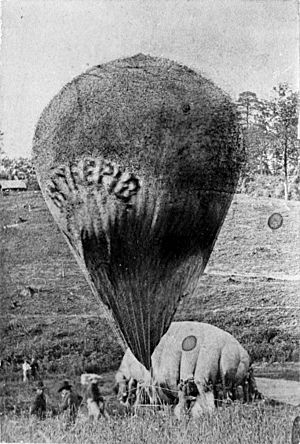
In July 1861, Lowe tried to use a balloon to observe the Battle of Bull Run. However, a storm delayed him. He then went to Fort Corcoran on July 27. For the next few days, he went up in the balloon many times. He made maps of the area and gathered information about Confederate troops moving toward Washington.
The information Lowe gathered was very useful. He was ordered to build larger balloons. His new balloon started making daily ascents from Fort Corcoran on August 30, 1861. It monitored Confederate troop movements. By September 11, General F.J. Porter was so impressed that he wrote, "You are of value now."
On September 24, 1861, Lowe did more than just observe. He actively directed artillery fire from nearby Camp Advance onto Confederate positions near Falls Church. This was the first time in American history that an aerial observer directed artillery fire.
Because of these successes, Lowe was allowed to build four more balloons. However, it was hard to repeat these successes in the field. The Balloon Corps' usefulness was limited. Also, there were disagreements between Lowe, who was a civilian, and the military officers. By early 1863, Lowe left the Corps. The Balloon Corps was eventually shut down in August 1863.
Daily Life at the Fort
Life at Fort Corcoran was not as hard as at some other forts. It was large and close to Georgetown. Officers and soldiers sometimes got permission to visit Georgetown or Washington. Soldiers at the fort played in regimental bands or played baseball in their free time. They also practiced infantry and gunnery drills.
Much of the work at the fort involved keeping the original structure in good condition. The fort had been built quickly after Virginia left the Union. A report from 1864 listed many improvements made to the fort. This work was usually done by the soldiers. However, at Fort Corcoran, some work was done by hired workers or freed slaves. This gave the soldiers more free time.
Life was not always easy, though. Because the fort was close to Georgetown, soldiers on leave sometimes clashed with civilians. For example, on March 7, 1866, a local resident complained that he was "assaulted and badly beaten by colored soldiers from Fort Corcoran at the Aqueduct Bridge."
Early's Raid and Beyond
During Early's Raid, which happened before the Battle of Fort Stevens, extra troops were sent to Fort Corcoran. They were there to help stop a Confederate advance on the Arlington Line. When it became clear that Confederate General Jubal Early's forces were moving further north, the additional troops at Fort Corcoran marched north to meet them.
In August 1864, the 10th New York Heavy Artillery Regiment was stationed at Fort Corcoran.
On April 18, 1865, the soldiers at Fort Corcoran took part in a national salute for President Lincoln. He had been assassinated four days earlier. At sunset, all ten guns at Fort Corcoran fired at the same time as guns at Fort Lincoln, Alexandria, and Camp Barry.
After the War
After General Robert E. Lee's Army of Northern Virginia surrendered on April 9, 1865, there was no longer a need for so many forts protecting Washington. Colonel Alexander, the chief engineer of Washington's defenses, suggested dividing the forts into three groups. Fort Corcoran was in the third group, meaning it should be completely abandoned.
To speed up the dismantling of the third-class forts, an order was given to store the guns and ammunition from them. Fort Corcoran was chosen as one of these storage locations. This saved it from being immediately taken apart. However, by the end of August 1865, funds were running low. More and more forts were dismantled, and the land was returned to its original owners. Fort Corcoran stored the cannons from the dismantled forts south of the Potomac River.
By October 1866, orders were given to list all the weapons at Fort Corcoran. This was to help move them to the Washington Arsenal or other permanent forts. Soon after, the fort was dismantled, and the land was given back to its original owner.
Today, the site of Fort Corcoran is at the intersection of Key Boulevard and North Ode Street in Arlington, Virginia. There are no parts of the fort left, but the Arlington County government has placed a historical marker there.
Images for kids
-
Union soldiers cross the Long Bridge during the occupation of Northern Virginia following that state's secession from the Union.
-
Portion of an 1865 map showing the location of Fort Corcoran. To the northeast is the Potomac River and Georgetown. The Aqueduct Bridge can also be distinguished.
-
Officers of the 69th New York Volunteer Regiment pose with a cannon at Fort Corcoran in 1861.Michael Corcoran at left.
-
The balloon Intrepid, one of six to eventually be constructed by Thaddeus Lowe and the Union Army Balloon Corps.
External Links
- U.S. National Park Service Historic Resource Study of the Civil War defenses of Washington, D.C.


